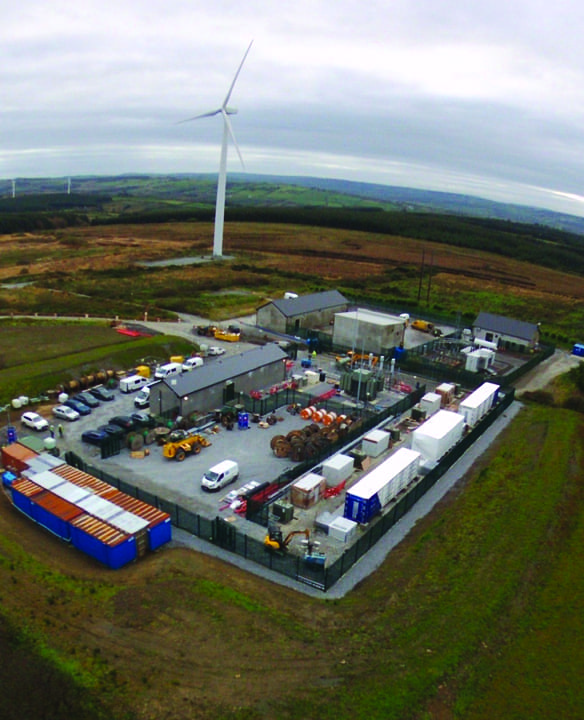Battery Storage: Perils and Promise
Lithium-ion battery technology promises the first realistic approach to fully integrating intermittent solar and wind into the U.S. power system. Despite its recent growth and great potential, the battery technology comes with a serious and dangerous downside: fire.
Pre-dawn last Sept. 2, an aquatics dive boat, the Conception, burst into flames off Santa Barbara, California, killing 34 of the 39 people onboard (Figure 1). The Los Angeles Times called it the “worst maritime disaster in modern California history.”
 |
|
1. The Conception commercial scuba diving vessel is shown here engulfed in flames after a deadly fire broke out aboard the boat on Sept. 2, 2019. Investigators determined a lithium-ion battery that was being charged caused the fire. Source: Creative Commons/Santa Barbara Sheriff’s Office |
Fire officials pointed to one of the many lithium-ion batteries onboard as the ignition source. The Times reported, “The fire underscored the potential dangers of such batteries, which have been banned from cargo areas of commercial planes and become the subject of tighter regulations by the U.S. Navy.”
It wasn’t an isolated incident. In April 2019, a 2-MW lithium-ion battery storage facility at an Arizona Public Service Co. (APS) substation near Phoenix exploded, injuring four firefighters. Ironically, the fire came at a facility in Surprise, Arizona.
Last September, a fire swept through an EnerSys battery factory making lithium-ion batteries for motive power in Richmond, Kentucky. The company reported that it expected “significant property damage and some amount of business interruption.”
The Promise of Batteries
Low-cost, high-capacity battery technology has long been the Holy Grail of the electric power industry. Local storage of electricity has been a potential solution for many electric utility problems, including making intermittent renewables more economic, smoothing load curves, and providing a new source of demand for power from electric vehicles. In the long-ago days of the “energy crisis,” when it seemed that Arab cartels could determine the price of crude oil and its derivatives, electric power became a goal to escape oil dependence. The ability to store power became desirable. That has largely meant batteries.
But better batteries were an unrealistic vision for many years. While battery technologies have been around for centuries, even millennium (see sidebar), finding a technology that would meet the needs of the electricity sector, including high power density, eluded the industry. The desire for ways to reduce greenhouse gases increased the appeal of energy storage.
|
A Long Battery History In 1938, a German archeologist discovered an unusual clay pot—dated to be 2,200 years old—at an excavation site near Baghdad, Iraq. Upon further analysis, experts determined it was a primitive electric battery. Speculation suggests that the device could have been used to electroplate gold onto a substrate of silver, a process still practiced in Iraq. The first well-understood battery came in 1800 from Alessandro Volta, an Italian inventor. Volta’s battery consisted of copper and zinc disks, separated by brine-soaked cardboard. Its ability to produce electricity was limited. In 1836, Englishman John Frederic Daniell invented a battery using an electrolyte of copper sulfate and zinc sulfate. It had a much longer lifetime than the Volta “pile.” An online history of battery technology said, “This battery, which produced about 1.1 volts, was used to power objects such as telegraphs, telephones, and doorbells, remained popular in homes for over 100 years.” The most familiar battery technology today, the lead-acid battery, which has started cars for generations, came from French inventor Gaston Plante in 1859. This has long been a workhorse of energy storage systems, including utility operations. Lead-acid technology has a well-understood weakness: The batteries can evolve explosive hydrogen. Last December, an array of lead-acid batteries at NRG’s 160-MW, four-unit, gas-fired Devon power plant in Milford, Connecticut, caught fire. Firefighters reported a “bank of 40, 3.1-volt lead acid batteries burning with flames near 15–20 feet high.” In 1980, American physicist John Goodenough invented a battery that uses lithium, the lightest metal on the periodic chart of the elements. It paired lithium with other metals, such as iron, manganese, cobalt, and nickel, to produce a current. It became a high-power-density technology, well suited to large-scale electric storage. It took more than a decade to realize its greater potential. Sony and Asahi Kasei created the first commercial application in 1991. |
In 1993, the new Clinton administration formed an alliance with the “Big Three” domestic car manufacturers (General Motors, Ford, and Chrysler) to focus on research and development of automobile battery technologies. This was the U.S. Advanced Battery Consortium (USABC). The Electric Power Research Institute and several investor-owned electric utilities agreed to cooperate with the ambitious project.
The USABC ultimately spent about $190 million, split evenly between the Department of Energy and the private sector, on the endeavor. It proved a bust (although the program continues, through an organization known as the United States Council for Automotive Research, or USCAR). The most promising technology was a sodium-sulfur battery, promoted by Ford. It had high energy density, but a fatal flaw: it tended to ignite unpredictably.
While the joint federal-industry research program faltered, South African engineer and entrepreneur Elon Musk in 2008 took the new cell phone lithium-ion batteries, ganged them up into a giant array, and put them into a Lotus Elite sports car chassis with an electric motor. Musk, co-founder of Tesla Inc., created the Tesla Roadster, the first of a series of cars that brought electric vehicles into the mainstream (although they remain a tiny portion of the worldwide automotive market).
Entrepreneurs quickly saw the promise of using lithium-ion technology to store electricity produced from solar and wind plants when the sun isn’t shining or the wind isn’t blowing.
A Lithium-Ion Revolution?
Lithium-ion technology seemed a revolutionary technology for renewables (Figure 2). There is much business activity among firms looking to pair the battery technology with wind and solar. Energy research and consulting firm Wood Mackenzie last fall looked at the non-residential storage market and predicted that falling prices would drive tenfold growth by 2024.
 |
|
2. Fluence, a Siemens and AES company that provides energy storage technology and services, partnered with Statkraft Ireland on a project located in Kilathmoy. A new 11-MW battery at the site is paired with a 23-MW onshore wind installation, providing split-second system support for Ireland’s electric grid. Courtesy: Statkraft |
In 2018, the U.S. Energy Information Administration (EIA) reported, “At the end of 2017, 708 megawatts (MW) of power capacity, representing 867 megawatt-hours (MWh) of energy capacity of large-scale battery storage capacity was in operation. Over 80% of U.S. large-scale battery storage power capacity is currently provided by batteries based on lithium-ion chemistries.”
EIA also foresees enormous growth. The agency said, “Growth in utility-scale battery installations is the result of supportive state-level energy storage policies and the Federal Energy Regulatory Commission’s Order 841 that directs power system operators to allow utility-scale battery systems to engage in their wholesale energy, capacity, and ancillary services markets. In addition, pairing utility-scale battery storage with intermittent renewable resources, such as wind and solar, has become increasingly competitive compared with traditional generation options.”
Congress hasn’t been helpful, refusing in December to provide energy storage investment tax credits, which the Energy Storage Association (ESA), the industry’s Washington trade group, pushed. ESA said it will continue to advance the concept. CEO Kelly Speakes-Backman, former Maryland state utility regulator, said, “This was a clear opportunity for Congress to address the urgent challenges of climate change and to support clean energy innovation.” She said her members “are not dissuaded from continuing our efforts to finally include energy storage in the [investment tax credit].”
Is Fire a Show-Stopper?
Fire is a major issue for lithium-ion batteries. Following the APS fire, the utility and Fluence, its battery supplier and a Siemens-AES Corp. joint venture, conducted a major review. The investigation, Greentech Media reported, “Is already reshaping how APS thinks about lithium-ion technology.” The fire has “delayed battery projects in Arizona, and has jammed safety to the top of the agenda in sales conversations with other utilities. U.S. utility-scale storage deployments are on track to underperform against expectations this year, although other market factors make it hard to isolate the effects of the fire.” The article notes, “It’s safe to say that the expected doubling of U.S. storage installations in each of the next two years will depend on whether or not the industry moves decisively to solidify confidence in battery safety following the Arizona failure.”
Last December, the ESA published “U.S. Energy Storage Operational Safety Guidelines.” It provides what ESA says is a “compendium of codes, standards, and additional guidelines to plan for and mitigate wide-ranging potential operational hazards.”
New Battery Technologies
The USABC late last year issued a “request for proposal information” for “Beyond Lithium-Ion” technology aimed at the auto industry. If successful, the research and development effort could impact utility-scale battery storage. Responses were due by March 20, 2020. The request said, in typical bureaucratic verbiage, that the program was seeking “industrial-scale development consistent with intended high-volume automotive usage, supported by a detailed cost model for the lithium-based cell and/or lithium electrode manufacturing, respectively.”
Researchers at the Johns Hopkins Applied Physics Laboratory (APL) in Laurel, Maryland, last fall reported what the lab described as a “flexible, cuttable, lithium-ion battery” that won’t catch fire. In a press release, APL said that current lithium-ion batteries “are susceptible to catastrophic fire and explosion incidents.” The lab’s new approach is water-in-salt (WiS) and water-in-basalt (WiBS) electrolytes incorporated in a polymer matrix that reduces water activity and elevates the battery’s energy capabilities and lifecycle. Furthermore, the design eliminates the flammable, toxic, and highly reactive solvents present in current lithium-ion batteries. “It’s a safe, powerful alternative,” according to the researchers.
While the technology is aimed at small uses, such as cell phone batteries, scale-up potential is attracting attention. Rensselaer Polytechnic Institute (RPI) in New York has also been working on a new water-based lithium-ion technology. The RPI scientists said their work demonstrates “the combination of fast-charging capability and the ability to store a large amount of charge per unit of volume.”
The RPI team said, “Achieving that kind of performance, with a low cost and improved safety, has practical implications. For emerging applications such as portable electronics, electric vehicles, and grid storage, the ability to pack the maximum amount of energy into a limited volume becomes critical.” ■
—Kennedy Maize is a long-time energy journalist and a frequent contributor to POWER.